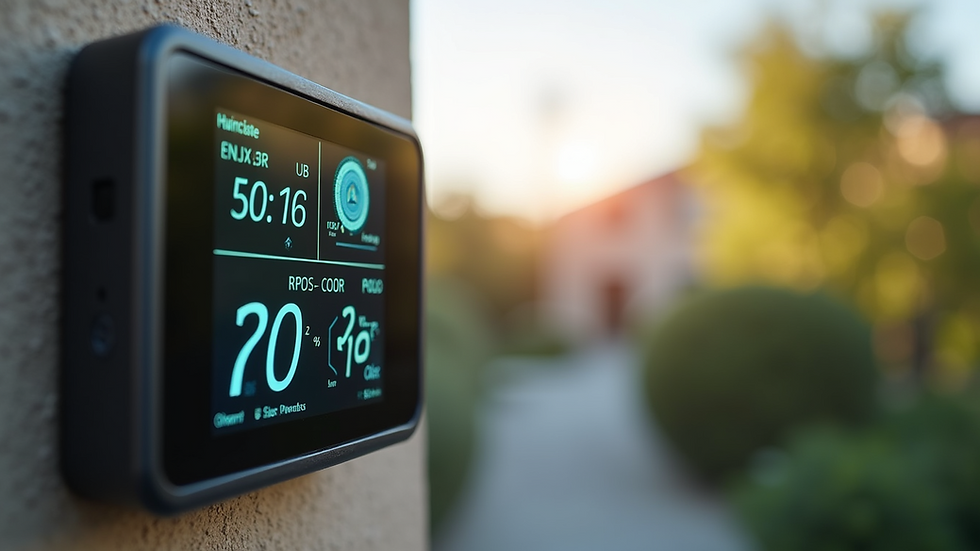How to Choose the Right solar system for Your Home and Maximize Its Benefits
- Jul 9
- 5 min read
Updated: Jul 15
As the demand for sustainable and cost-effective energy solutions grows, many homeowners are turning to solar energy. Choosing the right solar system for your home can feel overwhelming with the plethora of options available. However, understanding a few key concepts can simplify your decision-making process.
This guide provides clear steps to help you select the solar system that best meets your needs while maximizing its benefits.
Understanding Your Energy Needs
To choose the right solar system, start by assessing your household's energy consumption. Here are the steps to do this effectively:
Review Your Energy Bills: Look at at least 12 months of energy bills to find your average monthly energy consumption measured in kilowatt-hours (kWh). For instance, if your bills show usage of 900 kWh on average, this will guide your calculations.
Identify Energy Peaks: Investigate any seasonal variations or specific spikes related to high-energy appliances, like air conditioners or electric heaters. For example, you might notice a jump to 1,200 kWh in summer due to cooling needs.
Consider Future Needs: Anticipate changes that might impact your consumption, like adding family members or buying electric vehicles. If you plan to purchase an electric car, your consumption could rise by an additional 300 kWh per month.
Understanding your energy needs provides clarity on the solar system you require.
Determining Solar System Size
Once you understand your energy consumption, you can determine the optimal size for your solar system:
Calculate System Size: The sunlight your area receives will dictate the required solar system size. In sunny regions, smaller systems suffice, while shaded areas may need larger systems to gather enough energy. For instance, Los Angeles may need 5 kW, while Seattle may require as much as 8 kW due to less sunlight.
Solar Panel Output: Most solar panels generate between 250 to 400 watts each. Suppose your energy needs total 900 kWh monthly, on average. If your panels produce 300 watts, you’d need around 10 panels in a sunny area (900 kWh / (0.3 kW x 5 hours of sunlight)).
Consult Professionals: Engaging with solar energy experts ensures precise measurements based on local conditions and technology advancements, helping you avoid costly mistakes.
Calculating the appropriate system size leads to maximum energy efficiency.
Choosing the Right Type of Solar System
There are three primary types of solar systems: grid-tied, off-grid, and hybrid systems. Here’s a closer look at each:
Grid-Tied Solar Systems
Grid-tied systems connect directly to the local utility grid. They allow homeowners to send excess energy back to the grid for credits or savings.
Pros:
Lower initial setup costs, typically between $15,000 to $25,000.
Access to grid power when solar energy isn't available.
Eligibility for various government incentives.
Cons:
Complete reliance on the grid can leave you without power during outages.
Off-Grid Solar Systems
Off-grid systems function independently of the grid. They generate all necessary energy from solar panels and usually require battery storage.
Pros:
Complete energy independence.
Ideal for remote locations without utility access.
Cons:
Higher upfront costs, often exceeding $30,000.
Ongoing maintenance of battery storage can be labor-intensive.
Hybrid Solar Systems
Hybrid systems incorporate features of both grid-tied and off-grid systems. They connect to the grid while also utilizing battery storage for energy independence.
Pros:
Flexibility and adaptability to changing energy needs.
Ability to retain power during grid outages.
Cons:
Typically the most expensive option, with total costs ranging from $25,000 to $35,000 due to battery dependencies.
Choosing the right system type largely depends on your energy needs, lifestyle, and budget.
Evaluating Solar Panel Options
Now that you've identified the system type that best fits your needs, it’s time to select the right solar panels. Key considerations include:
Efficiency: This indicates how well the panel converts sunlight into electricity. Higher efficiency panels (above 20%) will produce more energy in limited space, essential for smaller rooftops.
Durability: Seek panels backed by warranties of 25 years or more and capable of withstanding local climate conditions. For instance, panels that can endure hailstorms are ideal in areas prone to severe weather.
Cost: Consider your budget not just for the panels but also for installation and anticipated long-term savings. While upfront costs might be more for premium panels, their efficiency can offer better returns.
Brand Reputation: Investigate manufacturers. Look for customer reviews and testimonials to gauge their service quality and product reliability.
Choosing the right panels can significantly enhance your system's performance and lifespan.
Finding a Reputable Installer
Once you’ve chosen a solar system and the right panels, seek a trustworthy installer. Follow these tips:
Check Qualifications: Verify that the installer is licensed, insured, and certified. Certifications from organizations like the North American Board of Certified Energy Practitioners (NABCEP) are particularly valuable.
Look for Experience: Choose a company with a proven track record in your area, as they are more likely to understand local regulations.
Read Reviews: Customer feedback is invaluable. Look for ratings on trusted platforms to get a sense of the installer's quality.
Get Multiple Quotes: Receiving estimates from several companies ensures you find the best deal regarding service and pricing.
A reliable installer ensures your system functions optimally and lasts longer.
Understanding Costs and Financing Options
Solar installation costs can vary, but understanding financing options can make your decision easier:
Purchase: Buying your system outright can result in maximum long-term savings. Without monthly payments, you'll pay off your investment faster.
Loans: Financing through personal loans or dedicated solar loans can spread costs over years, making payments manageable.
Leases and Power Purchase Agreements (PPAs): These options allow installers to own the system while you pay a fixed rate for energy produced. However, they may not qualify for tax incentives.
Incentives and Tax Credits: Take advantage of federal, state, and local incentives. For example, the federal investment tax credit (ITC) allows homeowners to deduct 30% of solar installation costs on their federal taxes.
Understanding these costs and financing options enables you to make an informed investment in solar energy.
Making the Most of Your Solar System
To enhance your solar experience, consider these tips:
Regular Maintenance: Check your panels often for dirt or debris that could hinder performance. A clean panel can boost efficiency by up to 25%.
Monitor Performance: Use monitoring systems to track real-time energy production and savings. Many systems allow you to access data through mobile apps for convenience.
Invest in Energy-Efficient Appliances: Upgrading to energy-efficient appliances can decrease overall consumption and make better use of your solar output.
Think Long-Term: The benefits of solar energy reach beyond immediate savings. Consider how solar contributes to environmental sustainability and reduces reliance on fossil fuels.
By applying these strategies, you can significantly enhance the value of your solar investment and support a greener future.
Final Thoughts
Choosing the right solar system for your home involves understanding your energy needs, selecting the appropriate size and type, picking quality panels, and finding a qualified installer.
Transitioning to solar energy is an important step toward sustainability. With careful planning, homeowners can enjoy the economic and environmental benefits of solar power for many years to come.
By equipping yourself with the right knowledge, harnessing the sun’s energy can be a gratifying and transformational experience.







😍
t
....